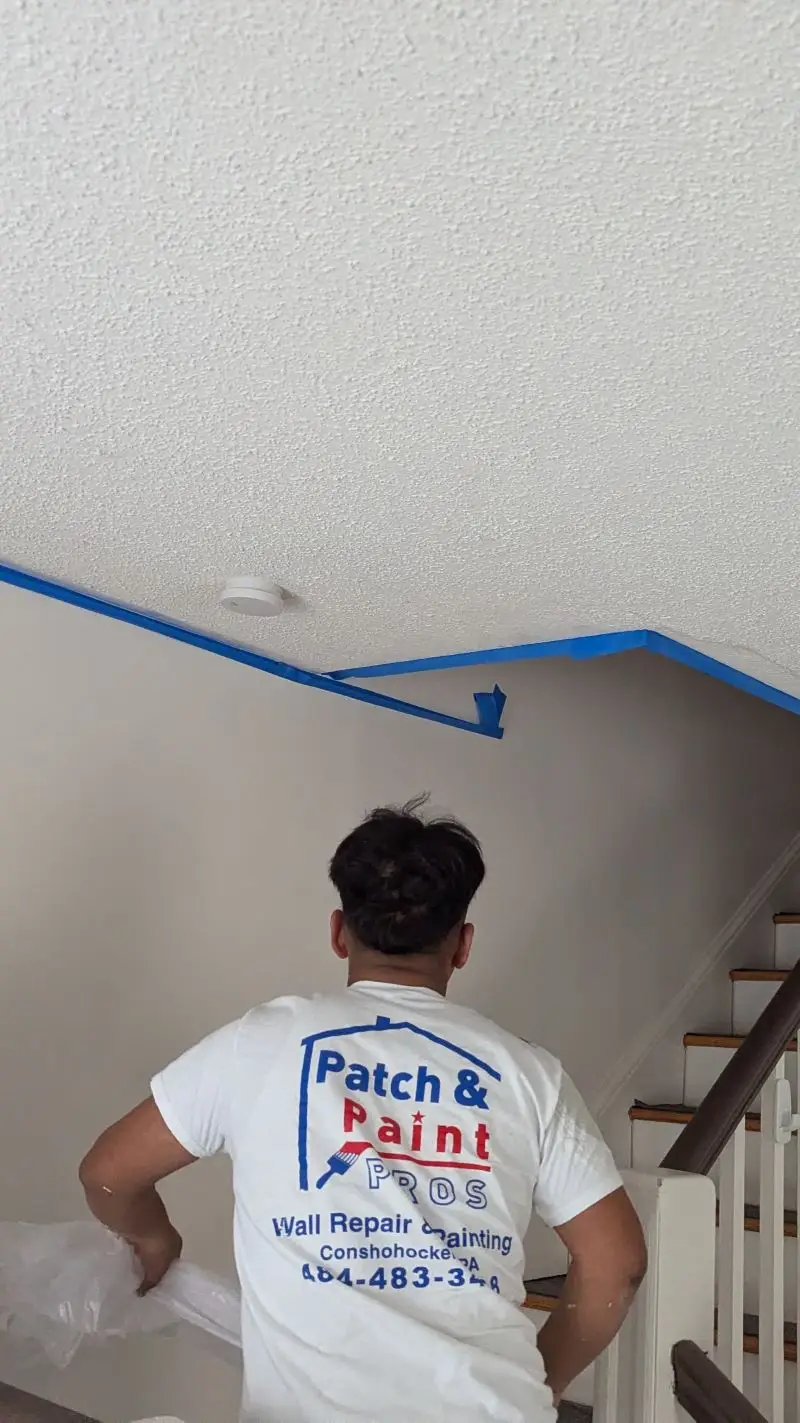As a local drywall and painting company serving Conshohocken, PA and surrounding areas, we often get asked about the difference between sheetrock and drywall. Here’s what every homeowner should know—plus when to call a pro.
Sheetrock and drywall are often confused with one another, but that is because they are both construction gypsum boards. “Sheetrock” is just the best known brand name of drywall (or gypsum board). This is kind of like how “Band-aid” is the best known name brand of adhesive bandages.
In this article, we’ll discuss what sets Sheetrock and drywall apart as well as which one is ultimately better. When it comes to choosing between sheetrock or drywall, you need to consider factors like cost, durability, installation process, environmental impact, and fire resistance.
Each material has its own set of pros and cons that should be weighed before deciding which product fits best with your project. We’ll go over all those details so you can make an informed decision about which option works best for you.
Or if you prefer to talk to someone about your upcoming drywall project in Montgomery, Chester or Delaware county, please give us a call at 484-483-3468.
It’s important to note that there are different types of drywall available on the market, and it’s essential to choose the right one for your project. Some types of drywall are designed for specific purposes, such as soundproof drywall, which is perfect for spaces where noise control is necessary, like recording studios or home theaters.
Moreover, building codes may require certain types of drywall in specific areas of your home. For example, in areas where moisture is prevalent, like bathrooms or kitchens, mold-resistant drywall may be required.
When it comes to installation, using the right type of drywall screws is crucial for a successful and secure installation. Make sure to choose the right size and type of screws to match the thickness and type of drywall you’re using.
With all of these factors taken into consideration, you can make an informed decision on which type of drywall to use for your project, ensuring that it meets your needs and adheres to building codes.
Another significant factor to consider when choosing between sheetrock and drywall is the type of building material you require for your project. For instance, moisture-resistant drywall is essential for bathrooms and other areas prone to high levels of moisture. Fire-resistant drywall is often mandated by building codes in specific areas, while wall studs also play a role in determining which material is best suited for a particular project.
When deciding between sheetrock and drywall for your project, it’s important to consider your specific needs and requirements. If you’re looking for a smooth wall finish, then properly installed drywall is usually the way to go. On the other hand, if soundproofing is a priority, then sheetrock may be the better option. It’s also worth noting that if the existing drywall is severely damaged or has excessive moisture damage, replacing it with new drywall or sheetrock may be necessary to ensure a safe and high-quality result.
Drywall and sheetrock may seem like distinct materials, but in reality, they are very similar. Both are construction materials composed of a gypsum core sandwiched between two layers of paper, and they are used interchangeably in many construction projects.
One key difference between the two is that sheetrock is a brand name of drywall made by the United States Gypsum Corporation. Another difference lies in their production process; sheetrock has a slightly denser core than drywall due to the addition of a small amount of wood fiber to the gypsum core. This makes sheetrock slightly stronger and more resistant to impacts than drywall.
Both drywall and sheetrock are commonly used to finish walls and ceilings in residential and commercial construction projects. They are typically installed using joint compound and paper tape to create a smooth wall or ceiling surface. For specialty applications such as moisture-prone areas, moisture-resistant drywall or Sackett board may be used. Overall, drywall sheets or boards are a versatile and durable option for any construction project.
With either option, you can rest assured knowing that your walls will remain strong and sturdy for years to come.
When it comes to environmental factors, sheetrock and drywall offer two different solutions. Sheetrock is made from gypsum – a material that can be mined naturally or created with synthetic materials. Drywall is usually composed of gypsum sandwiched between two pieces of paperboard.
Both products have their own benefits in terms of indoor air quality and water damage prevention:
In addition, both types of wallboard are treated with fire-retardant chemicals to reduce the risk of fires spreading quickly through walls or ceilings.
These advantages make either type of wallboard suitable for most residential applications, but depending on your particular needs one might be better suited for your situation than the other. As such, when deciding between sheetrock and drywall you should consider all the pros and cons based on what you’re trying to achieve in order to make an informed decision about which product best suits your project’s requirements.
When it comes to selecting the best material for your building project, it’s important to consider factors such as fire resistance, moisture control, and ease of installation. Both sheetrock and drywall offer excellent protection against fire and moisture.
Sheetrock consists of a core of gypsum sandwiched between two sheets of heavy paper, while drywall is made up of several layers of plasterboard or gypsum board. Sheetrock has a higher level of fire resistance because of its specially treated core material, which makes it more resistant to heat and flames than regular drywall. It also provides better moisture control due to the paper backing that helps to keep out excess water vapor.
Furthermore, sheetrock requires less skill and effort to install compared to traditional drywall panels, which can save you time and money. If you’re looking for a material that is extra durable and offers enhanced fire protection, sheetrock may be the best option. However, for those looking for a cost-effective solution, drywall is a great option, as it is less expensive per square foot compared to sheetrock. Ultimately, the choice between the two depends on your specific needs for the project, whether it be for plaster walls, ceiling drywall, or sheets of drywall.
Though slightly pricier than standard drywall, it’s worth considering if your project demands top-notch fire safety features.
The debate over sheetrock vs. drywall has been raging for decades, but there’s no clear winner. Ultimately, it comes down to the individual needs of each project. Sheetrock is more cost-effective and easier to install, while drywall offers superior durability and fire resistance.
No matter which one you choose, I think we can all agree that sheetrock and drywall have something in common: they both look like a bunch of white squares stuck together! So if your walls are looking bland or boring, just remember that with a little imagination (and some paint) you can turn them into works of art.
At Patch and Paint Pros, we specialize in drywall repair and interior painting for homes in Conshohocken, Plymouth Meeting, and nearby towns. Whether it’s sheetrock or drywall, we’ve got you covered.
or

